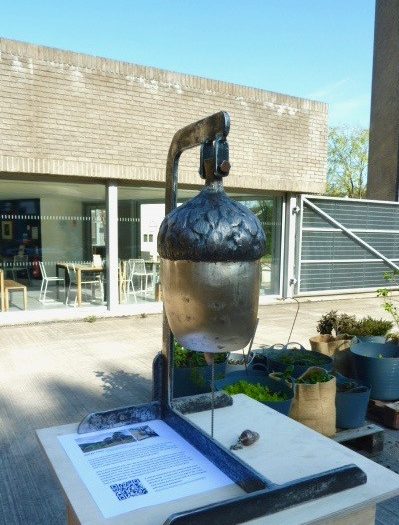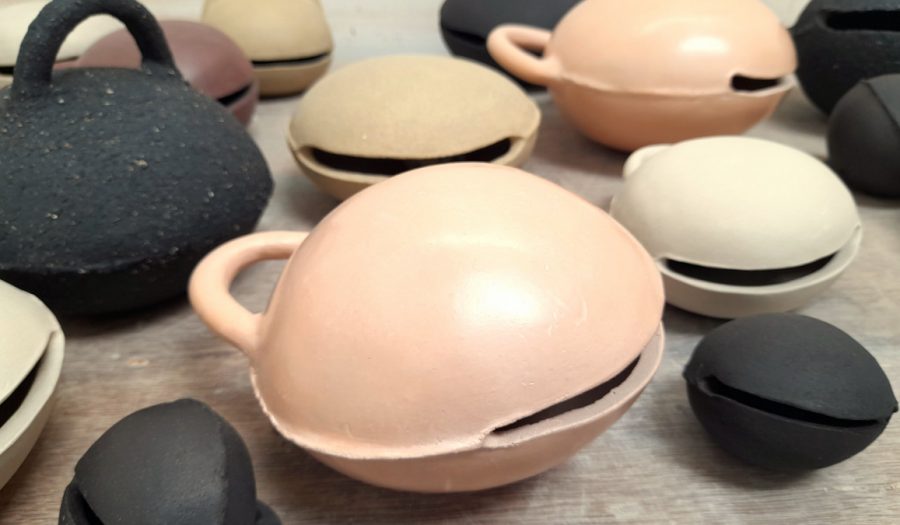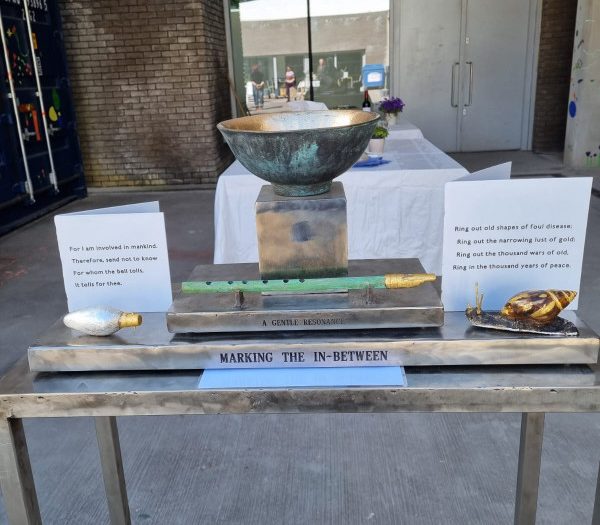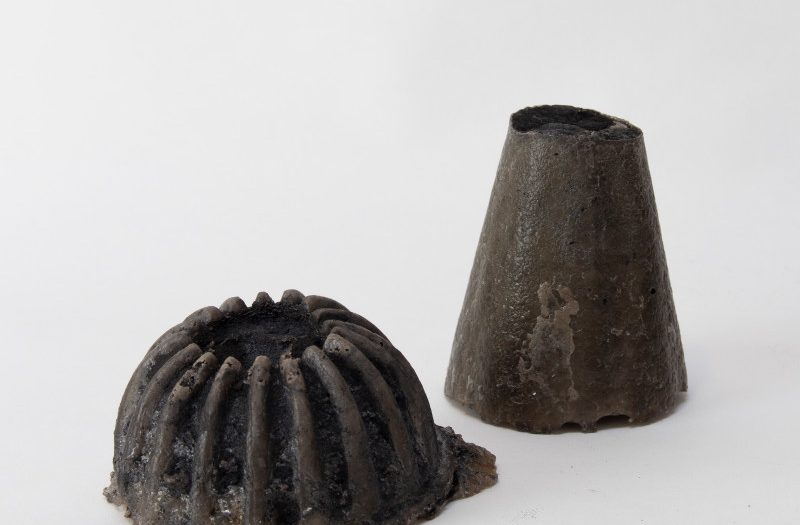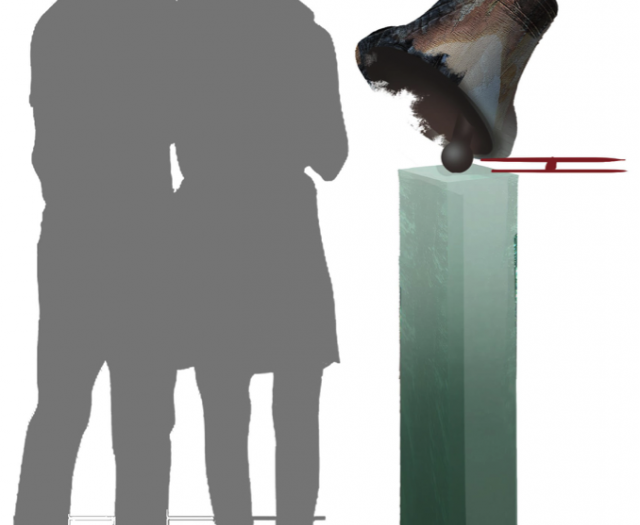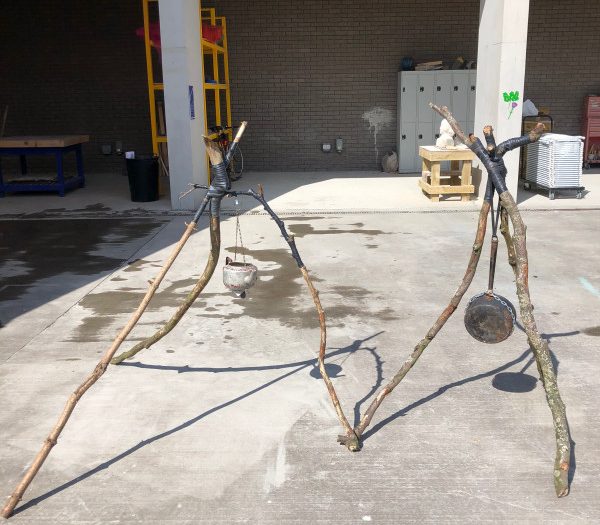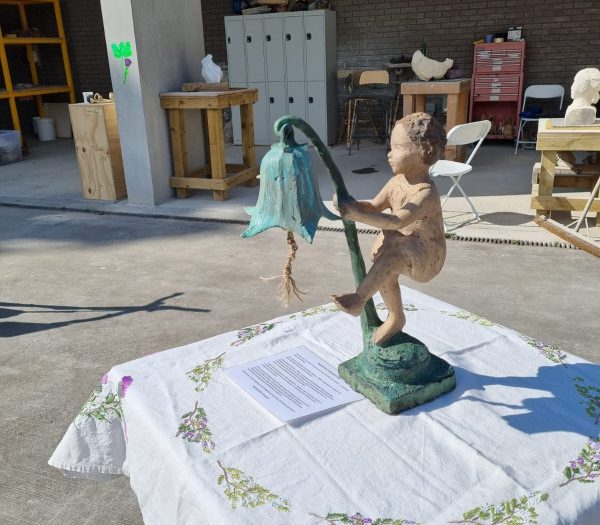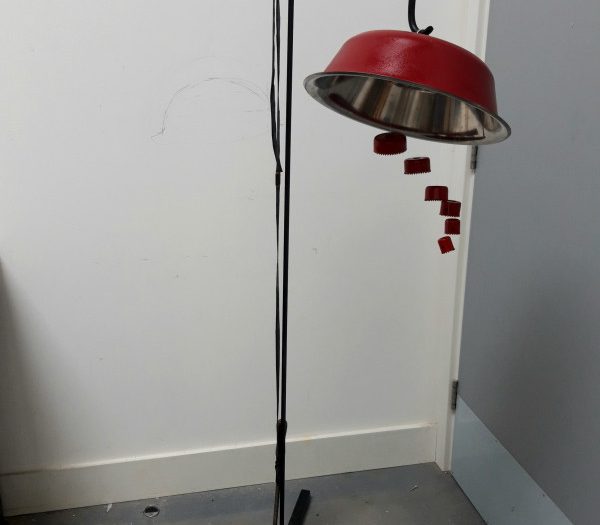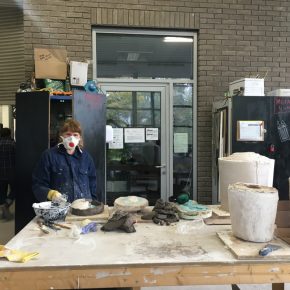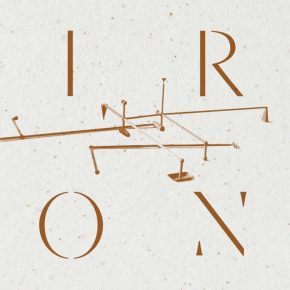Members’ Bell Project
Since late 2021 ESW members have been collaborating on The Bell Project a series of multi-disciplinary responses to the history and symbolic significance of bells.
The project evolved from the lifting of restrictions after lock-down in 2021, with the aim to bring members together after several months of working in isolation coupled with the information regarding the closure of the Whitechapel Bell Foundry, the oldest manufacturing company in Great Britain.
Historically, bells were rung by the town crier, sounded time in the working day, have been used as a call for prayer or raise alarm about imminent dangers. Bells are rung in celebration, at festivals, start of a new year or end of medical treatment.
Bell for Trees, Fanny Lam Christie
The acorn seeds symbolize growth and new life. Some seeds will grow into the oak trees to provide habitat for wildlife and many moss, lichen species. They also provide important food source for wildlife during winter, such as red squirrels, deer, the blue jays and others. Fanny created a bell in the shape of an acorn. The acorn bell consists of two layers, a smaller seed inside the big acorn, to signify regeneration.
Stephen Murray performed drumming the acorn bell at the Bell project launch at ESW on Friday, 29 April as a clarion, call for your participation to plant a tree in the Scottish Caledonian forest. Our native woodlands would slowly disappear if we do nothing about it. The recent storm events have drastically damaged a large number of woodlands across Scotland. We need your help recover our threatened environment and biodiversity. Fanny has set up a ESW tree grove with the Treesforlife charity to plant new trees in the Highlands.
You can find out more about Fanny’s work here.
It costs £6 contribution for the charity to plant a tree on your behalf. To help create a wild forest, scan the QR code or go to ESW Tree Grove page to join. We very much look forward to see the birth of a new tree grove with your kind participation.

Hand built ceramic bells with natural clay finish. Leesa French.
Terra Sigillata has been used as a sheen on some of the bells.
Each has one or two ceramic balls enclosed which create the sound, and each bell has a distinct tone.
The form is based on Tiger Bells from the Philippines (Filipino Tiger Bells are very much smaller than these ceramic ones). Crotal or Jingle bells are similar in that they have an enclosed pellet. Tiger Bells are found throughout South-East Asia where they are worn by folk as charms or amulets or as accompaniments to dance. Cats and other animals wear Tiger Bells in Afghanistan, Malta, and widely in Indonesia. There is a strong link between tiger bells and shamanism, with associated costumes and paraphernalia heavily adorned with bells.
Leesa is also working on a series of other works entitled The Listeners, to accompany the bells. These ‘figures’ are inspired by the giant ears based on the South coast of England – designed to listen out for enemy aircraft in the 1920s and 30s.
Marking the In-between, Andrew Kinghorn, Bronze and stainless steel
From the past I toll for thy future
Paul McCauley have always been interested in ancient and historic artefacts , how they were made and their ritual or spiritual significance.
Bells have importance in many cultures through their resonance and vibration which literally moves people.
For the Bell Project McCauley wanted to create a ceramic bell which would ring, but did not want to make a traditional shaped bell; so used the square shape of St Patrick’s bell shrine as a template for his work. It was made of bronze and gold in the 10th century to hold the real relic of a simple cow-bell.
Now over a thousand years later the objects retain the energy of peoples veneration but are now cultural museum artefacts rather than spiritual objects.
The replica standing stone is inspired by the early Irish Celtic Kildeas stone in County Fermanagh which depicts a ‘Culdee’ monk who travelled and preached with bell and crozier (a shepherds crook).
His cast iron ding dong bell – wake up quick is an call to us all to be awake and aware of issues facing us in modern life!
Fiona & Clive McLachlan Powell
Fiona & Clive McLachlan Powell have been making drawings and bells forms created through metal and molten salt casting a process developed by Clive together with the foundry at ECA. They are exploring the links between bells, humans and animals with anthropomorphic and organic shapes in the pieces, drawings and sounds. The sound piece for the project is created from recordings of resonance in stone, wood and water, together with small bell like sounds of salt re-crystallising in iron troughs, that can play by itself or as an undertow to folks making sounds on bells.
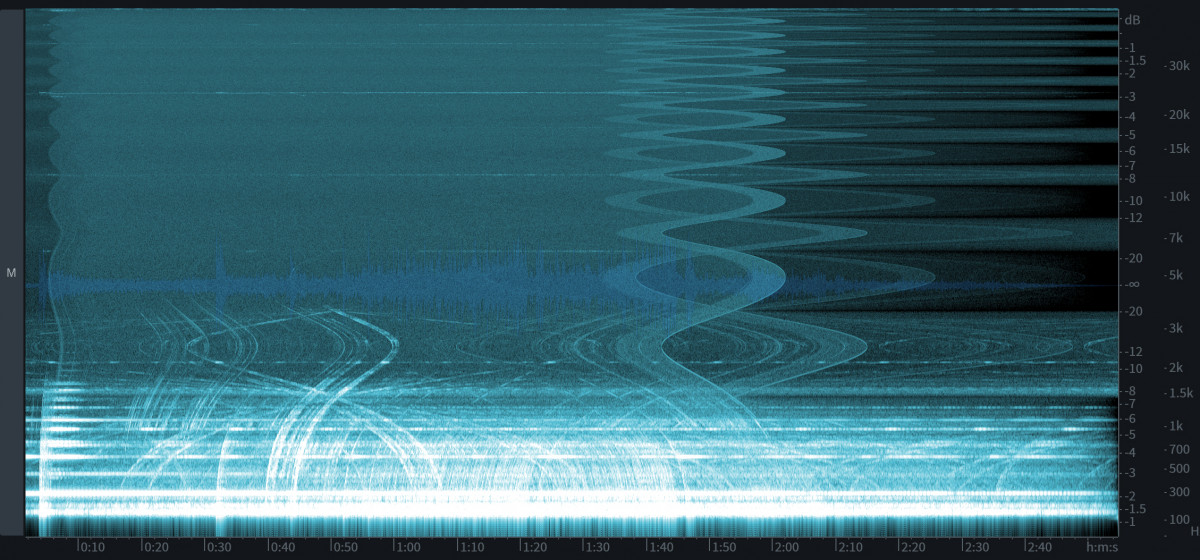
Frequency image from the sound piece.
Gabriel, John McDowell, work in progress
Scottish pippy oak with lettering, guilded with gold leaf to crossbanded lime wood on opaque glass and concrete.
VOX EGO SUM AMORIS. GABRIEL VOCOR.
I am the voice of Love. Gabriel is my name.
A sculpture inspired by novelist and philosopher, Iris Murdoch and her 1958 novel The Bell. Named after the bell in the book, Gabriel is central to the myth around which the story of the novel revolves. The sculpture is modelled on a real Gabriel, one of Notre-Dame de Paris’ peal of bells and, like the book, dwells on universal themes of identity and acceptance.
Most of our love is shabby stuff, but there is always a thin line of gold, the bit of pure love on which all the rest depends — and which redeems all the rest – An Unofficial Rose, (1962) Iris Murrdoch
Ringing routine, Fiona Maher
Fiona Maher’s ‘Bells’ are made from found objects , collected from an old dump from a now disbanded care home for young adults. The objects are vessels associated with meal times which punctuate the daily routine within institutional and domestic life . Transformed into ‘bells’ these domestic objects hang in limbo waiting to summon eager diners to an anticipated meal .
Cacerolazos – pots & pans protest
The “cacerolazo” protest tradition dates back to centuries. It first began in medieval times when villages would use charivari, or “rough music” to give voice to their displeasure . A cacerolazo is a form of popular protest which consists of a group of people making noise by banging pots, pans, and other utensils in order to call for attention.
The first documented protests of this style occurred in France in the 1830s, at the beginning of the July Monarchy, by opponents of the regime of Louis Philippe I of France. According to the historian Emmanuel Fureix, the protesters took from the tradition of the charivari the use of noise to express
disapproval, and beat saucepans to make noise against government politicians. This way of showing discontent became popular in 1832, taking place mainly at night and sometimes with the participation of thousands of people.
More than a century later, in 1961, “the nights of the pots” were held in Algeria, in the framework of the Algerian War of Independence. They were thunderous displays of noise in cities of the territory, carried out with homemade pots, whistles, horns and the cry of “French Algeria”.
You can find out more about Fiona’s work here.
Bluebell and Bluebell Child, Hannah Rosnes
After moving to Edinburgh from Bergen, Norway in 2008 Hannah Rosnes often went for walks in and around Edinburgh with her partner.
In the spring and summer of 2009 she was amazed at all the bluebells in the surrounding woodland but they were not the type of bluebell she was used to seeing in the wild in Norway. She started to look for that bluebell when on walks and finally found a few, very remote, on the peninsula between Gullane and Aberlady.
This bluebell, the Scottish Bluebell or Harebell, was not common growing mainly in Scotland, rarely in England. It is found away from farmland and is sensitive to its environment.
When Norway gained independence at the beginning of the twentieth century it was one of the poorest countries in Europe. Both Hannah and her partner were supporters of Scottish Independence and she remain a supporter. Her partner passed away in 2016 without experiencing the Independence for Scotland he so wished for.
This sculpture is her contribution to the independence movement of Scotland. Its name the Scottish Bell of Freedom.
Arrival, Paulina Sandberg, metal, sound sculpture, iron and found stainless steel objects.
A sculpture to be played rather than spoken or written about.
You can find out more about Paulina’s work here.

